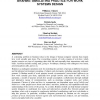87 search results - page 3 / 18 » What makes workflows work in an opportunistic environment |
IJMMS
1998
13 years 5 months ago
1998
A continuing problem in business today is the design of human-computer systems that respect how work actually gets done. The overarching context of work consists of activities, wh...
IWC
2010
13 years 3 months ago
2010
In this paper a study is presented which aimed at exploring the effects of audio feedback in a haptic and visual interface supporting collaboration among sighted and people who ca...
PERCOM
2005
ACM
14 years 4 months ago
2005
ACM
There is a huge effort in ongoing research on new middleware platforms and new distributed services to support ubiquitous environments and pervasive applications. Most research pr...
LREC
2010
13 years 6 months ago
2010
We present the ABLE document collection, which consists of a set of annotated volumes of the Bulletin of the British Museum (Natural History). These were developed during our ongo...
HPDC
2010
IEEE
13 years 6 months ago
2010
IEEE
Cloud computing is increasingly considered as an additional computational resource platform for scientific workflows. The cloud offers opportunity to scale-out applications from d...


